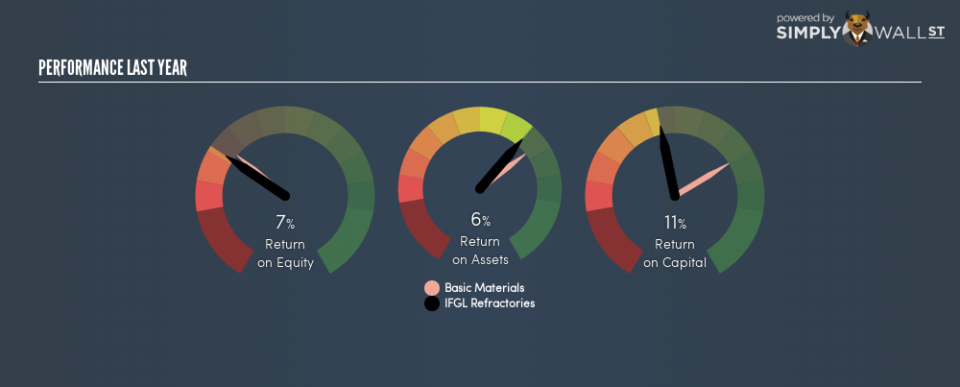How Do IFGL Refractories Limited’s (NSE:IFGLEXPOR) Returns On Capital Compare To Peers?

Today we’ll evaluate IFGL Refractories Limited (NSE:IFGLEXPOR) to determine whether it could have potential as an investment idea. Specifically, we’re going to calculate its Return On Capital Employed (ROCE), in the hopes of getting some insight into the business.
First of all, we’ll work out how to calculate ROCE. Second, we’ll look at its ROCE compared to similar companies. And finally, we’ll look at how its current liabilities are impacting its ROCE.
What is Return On Capital Employed (ROCE)?
ROCE measures the amount of pre-tax profits a company can generate from the capital employed in its business. Generally speaking a higher ROCE is better. Overall, it is a valuable metric that has its flaws. Renowned investment researcher Michael Mauboussin has suggested that a high ROCE can indicate that ‘one dollar invested in the company generates value of more than one dollar’.
So, How Do We Calculate ROCE?
Analysts use this formula to calculate return on capital employed:
Return on Capital Employed = Earnings Before Interest and Tax (EBIT) ÷ (Total Assets – Current Liabilities)
Or for IFGL Refractories:
0.11 = ₹789m ÷ (₹10b – ₹2.2b) (Based on the trailing twelve months to September 2018.)
Therefore, IFGL Refractories has an ROCE of 11%.
See our latest analysis for IFGL Refractories
Want to help shape the future of investing tools and platforms? Take the survey and be part of one of the most advanced studies of stock market investors to date.
Does IFGL Refractories Have A Good ROCE?
One way to assess ROCE is to compare similar companies. Using our data, IFGL Refractories’s ROCE appears to be around the 9.9% average of the Basic Materials industry. Aside from the industry comparison, IFGL Refractories’s ROCE is mediocre in absolute terms, considering the risk of investing in stocks versus the safety of a bank account. Readers may find more attractive investment prospects elsewhere.
IFGL Refractories’s current ROCE of 11% is lower than 3 years ago, when the company reported a 19% ROCE. This makes us wonder if the business is facing new challenges.
When considering this metric, keep in mind that it is backwards looking, and not necessarily predictive. ROCE can be misleading for companies in cyclical industries, with returns looking impressive during the boom times, but very weak during the busts. This is because ROCE only looks at one year, instead of considering returns across a whole cycle. Future performance is what matters, and you can see analyst predictions in our free report on analyst forecasts for the company.
Do IFGL Refractories’s Current Liabilities Skew Its ROCE?
Short term (or current) liabilities, are things like supplier invoices, overdrafts, or tax bills that need to be paid within 12 months. Due to the way the ROCE equation works, having large bills due in the near term can make it look as though a company has less capital employed, and thus a higher ROCE than usual. To counteract this, we check if a company has high current liabilities, relative to its total assets.
IFGL Refractories has total assets of ₹10b and current liabilities of ₹2.2b. As a result, its current liabilities are equal to approximately 21% of its total assets. It is good to see a restrained amount of current liabilities, as this limits the effect on ROCE.
Our Take On IFGL Refractories’s ROCE
If IFGL Refractories continues to earn an uninspiring ROCE, there may be better places to invest. But note: IFGL Refractories may not be the best stock to buy. So take a peek at this free list of interesting companies with strong recent earnings growth (and a P/E ratio below 20).
If you are like me, then you will not want to miss this free list of growing companies that insiders are buying.
To help readers see past the short term volatility of the financial market, we aim to bring you a long-term focused research analysis purely driven by fundamental data. Note that our analysis does not factor in the latest price-sensitive company announcements.
The author is an independent contributor and at the time of publication had no position in the stocks mentioned. For errors that warrant correction please contact the editor at editorial-team@simplywallst.com.

